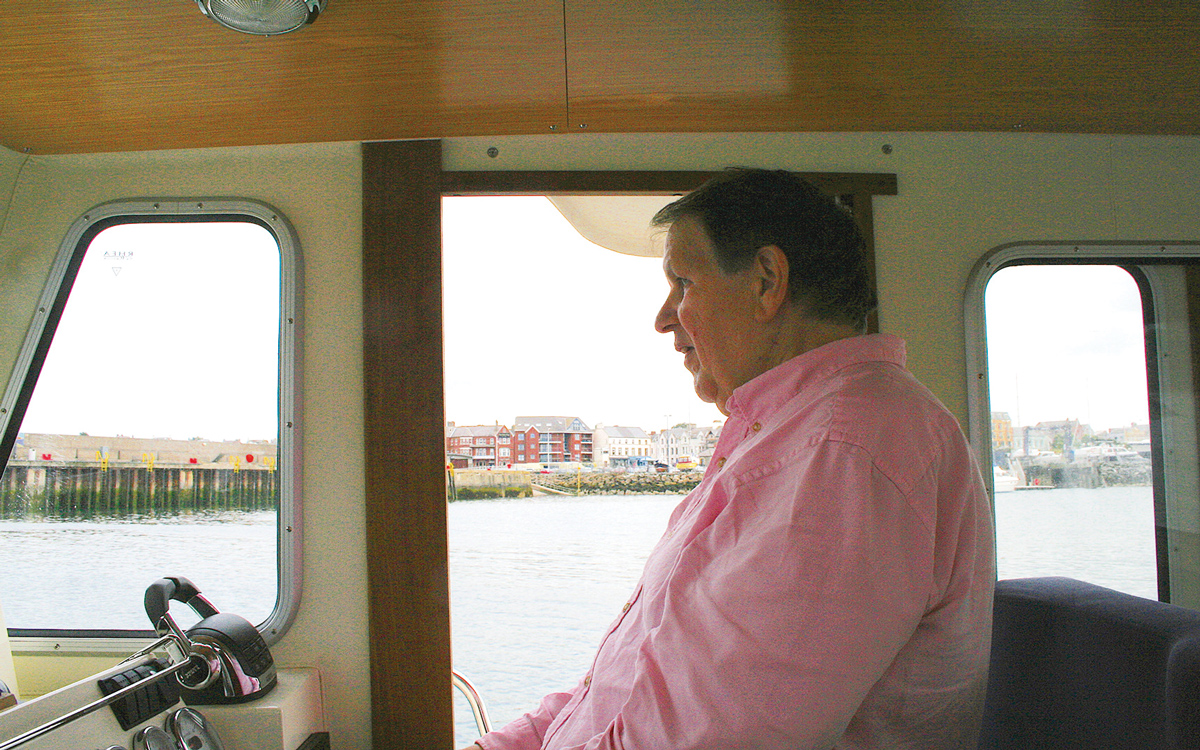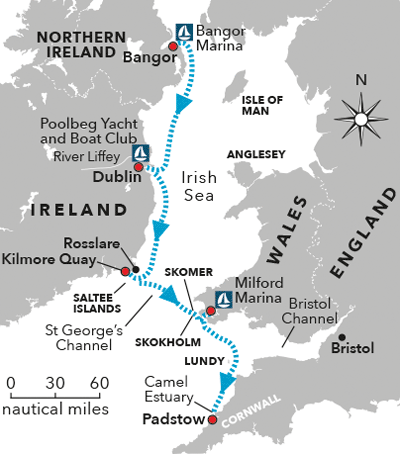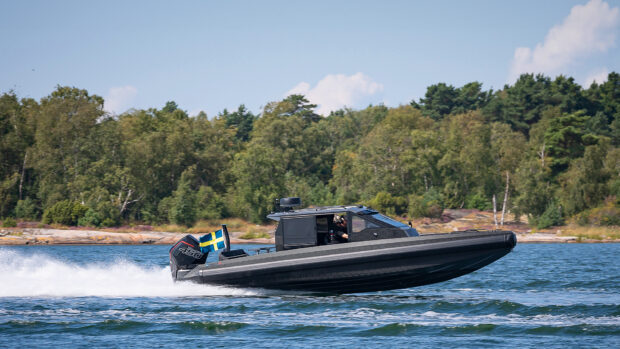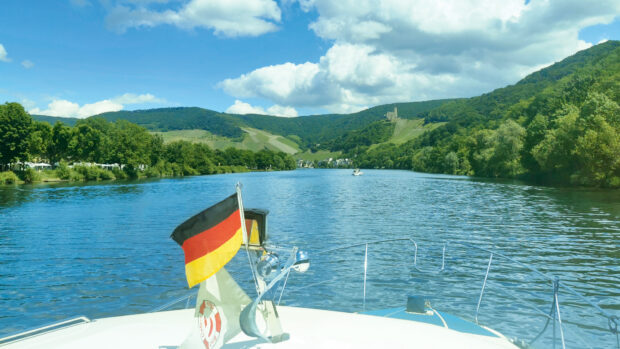Having survived the perils of Cape Wrath, Philip Davies and Nigel Boutwood press south along the east coast of Ireland before crossing to Wales and Cornwall’s north coast...
This is part six of Phillip Davies and Nigel Boutwood’s round Britain adventure. You can read part one here.
So far our mission to circumnavigate Britain in my 27ft Rhea 850 Start Me Up in aid of charity has gone remarkably smoothly. We have made it all the way up the east coast, round the top of Scotland and back down to Bangor Marina in Northern Ireland.
However, a spell of bad weather forced us to leave the boat there for a few days while we headed back home to Sussex for a spot of R&R.
Feeling much refreshed and with the weather perking up too, we fly back to Belfast and are back on Start Me Up by 13:00. The weather and sea forecasts look so good that we decide to set off immediately rather than wait for the following morning.

We are heading for Poolbeg Yacht and Boat Club on the River Liffey in Dublin, a 109-mile leg that we hope to complete before 20:00 to enjoy an evening in Ireland’s fair city.
We beat our own estimate and arrive in Dublin Bay by 19:00 after an incident-free passage over smooth to slight seas. We seek and gain permission from the port authorities to cross the main (big ship) channel and enter the busy harbour through the small boat channel, keeping out of the way of the various ferries, cruise liners and commercial ships that frequent it.
We have chosen Poolbeg because of its proximity to Dublin city centre, and of course a fuel pontoon. We try without success to let them know of our imminent arrival via VHF but only manage to get a response whilst treading water in front of it, and then only from berth holders who happen to be listening in and direct us towards a spare berth.

In Ireland – home of Guinness and competitively priced white diesel
To be fair to Poolbeg Y&BC during office hours the whole operation is run very efficiently by the guy behind the club bar and once we are alongside, the hospitality and welcome could not be better. We hose down the boat, connect the electricity and prepare to hit the town.
When in Dublin…
Nigel has expressed a desire to spend a couple of days in Dublin as he has never been there before, so the next day we stroll around this compact city at our leisure, using the ‘Hop on Hop off Bus’ route map as a guide.
We end up in the famous Temple Bar district, where we indulge in a delicious Irish Stew accompanied by a Guinness or two at O’Donoghue’s pub – famous for its association with The Dubliners amongst others.

Nigel outside Trinity College
It’s true that Guinness really does taste better in Dublin but after our whisky tasting experience in Scotland we also feel duty-bound to try the finest Irish whiskey on offer to see how it compares.
The bar tender at the Quays pub recommends the award-winning Redbreast 12-year single pot still but good as it is we still prefer the 17-year-old Bunnahabhain we imbibed in Port Ellen.
Dublin to Kilmore Quay
The next morning we move on to the diesel pontoon, which seems an extraordinary distance from the pump. I ask the duty manager how it works.

Kilmore Quay where the seas are blue and the fish and chips are epic
He tells us to reel out the hose and promises it will be long enough to reach. Nigel is dispatched to do just that and after a considerable effort, it does. How much is white diesel in Ireland? One euro per litre! The second least expensive diesel on the trip.
We phone ahead to book a berth at Kilmore Quay, a small but very popular transit marina on the southern Irish coast. The approach to the marina is navigationally challenging with multiple offshore rocks to be avoided and a couple of small islands (the Saltee Islands) in the way.
However, so long as it is well planned and executed with care it presents no real problems. The marina manager asks what time we are arriving and what our draft is. According to Reeds Alamanac, Start Me Up’s 800mm draft should be fine at any state of tide.
Article continues below…

Cruising around Britain in a 27ft boat: Part 1 – Gosport to Ramsgate

Cruising around Britain in a 27ft boat: Part 5 – Kinlockbevie to Bangor
The manager confirms this but recommends that we arrive an hour before low tide for comfort’s sake. As this is an 86-mile leg with slight but occasionally moderate seas forecast we should arrive at half tide. The first 55 miles pass without incident but approximately 20 miles before Rosslare, the ferry port at the bottom of the east coast of Ireland, the wind and sea state picks up and visibility becomes very poor.
We slow down to less than 10 knots, pushing our expected arrival time back significantly. Our original passage plan avoided some tidal races and charted rocks but there is another slightly more challenging but perfectly safe course between the Saltee Islands into the harbour that could save us almost an hour. We take the short cut and manage to get there an hour before low tide, just as we’d hoped.
Kilmore Quay is a very attractive village with a couple of lovely pubs and the fish and chips are epic. The locals have a wonderfully laid-back demeanour and we decide that this would be a lovely place to be trapped for a few days. This time, however, the weather gods are with us as the winds are turning westerly, giving us a potentially comfortable passage across St George’s Channel to Milford Haven in south-west Wales the following day.
Kilmore Quay to Milford Haven
A Welsh gentleman we had met the previous evening stops at the stern of our boat asking whether we are still leaving for Milford Haven today. He recommends his homeport of Milford Marina and wants to know what our passage plan is.
I tell him we are going south of the Smalls (nasty rocks, not underwear) and outside Skomer and Skokholm islands, a few miles off the Pembrokeshire coast and a half-an-hour from Milford Haven entrance, thereby missing the various tidal races and other navigational nasties that lie in wait.

Milford Haven greets the crew after a comfortable passage from Ireland to Wales
His advice, once we have cleared Kilmore Quay approaches, is to head directly for St Ann’s Head and its lighthouse at the western entrance to the Haven. This means going north of the Smalls and between Skomer and Skokholm islands, where the tides races are, but he assures us they are only uncomfortable for half a mile and will save us a lot of time.
We fuel up on the self-service pontoon and head out of the harbour. Having cleared the approaches we set a course directly for St Ann’s Head and true to our Welsh friend’s word, after 3.5 hours of a gentle following sea, we skip over the rippling races between Skomer and Skokholm to arrive at the entrance to Milford Haven some 30 minutes later.
We make our way up the magnificent Milford Haven until the lock for Milford Marina comes into view. We contact the lockmaster via Channel 14 and are told to take the starboard pontoon in the large lock. Once alongside the VHF bursts into life again informing us where to berth for the night. Ten minutes later we are on it and the cold beers make a swift appearance to celebrate our arrival in Wales.

Bidding farewell to Milford Haven
Milford Marina is indeed a decent facility but it is a given that you are invariably better off fuelling when you arrive than when you leave, and particularly here as you have to book it. This we do and are therefore in a good position to get an early lock out the following morning.
That evening we eat in one of the many fine-looking pub/restaurants in the marina. We ask the duty manager on the way back to the boat what the procedure is for locking out.
It has to be booked, so we book it there and then for the first available slot at 09:30. The wind is swinging round to being northerly and therefore perfect for the 70-mile passage across the Bristol Channel to Padstow in Cornwall, almost directly south of Milford Haven.

Getting to Padstow is going to be a big moment for several reasons: I have always wanted to arrive there by boat, we would be back in England for the first time in weeks, and most importantly I could start my survey of who makes the best Cornish pasties in the UK.
Milford Haven to Padstow
Padstow is the only genuine port of refuge on the north Cornish coast, indeed almost the only place on the south-west peninsular west of the River Avon and Portishead Marina. Arrival for entry to the inner harbour, where the boat stays afloat, is two hours either side of high water (14:30 that day) so I am going to allow five hours for this 70-mile passage across the outer Bristol Channel.
I phone to book a berth but not for the first time my call goes unanswered. I try again 20 minutes later but still no answer. I leave a message letting them know that we are on our way and hope that they will return the call to confirm there’s space for us before we actually have to set off.

Back on English soil to the hustle and bustle of Padstow
The weather and sea forecast are too good not to take advantage of and we decide that we are going anyway. Start Me Up is actually capable of taking the ground if needs must and the Camel Estuary has plenty of sheltered spots where we can do this; however, we would much rather be afloat in the harbour.
The Milford marina lockmaster calls us at 09:15 to invite us to take our place for the lock and 25 minutes later we are heading back down an empty Milford Haven, finally clearing the approaches and heading due south to Padstow by 10:00.
Some two-and-a-half-hours later we make out Lundy Island a dozen miles to the east of us and an hour later we can see what we think must be the entrance to the Camel Estuary. I was once told by a very experienced skipper that mariners always look too soon and are invariably too far away to make a proper judgement about harbour entrances or significant landfalls.
We promised ourselves that we wouldn’t do this but yet again we fall for it and have to wait a while before the real estuary hoves into a view. The estuary is navigationally challenging but nothing extraordinary. The infamous Doom Bar does need to be avoided, even though the name is actually a Cornish derivative of ‘dune’ rather than the more ominous English meaning.
We are 45 minutes early as we motor past the green conical buoy that marks the extremity of Doom Bar. Padstow Harbour is not answering on the preferred Channel 12 so I keep within the channel markers on a rising tide until we are answered.
It’s no hardship as the turquoise seas and white sand beaches of Polzeath are truly stunning. Eventually a harbour patrol RIB powers up to us and asks whether we are the boat calling channel 12. He tells us there is a waiting pontoon just outside the harbour cill gate and offers to escort us to it.
Five minutes later we are safely alongside the waiting pontoon and shortly after the duty manager calls in on us. All of the pontoon fingers are occupied but there is a spot for us against the harbour wall itself.
The only downside is that there’s a two-metre tidal range while the gate stays open, so we’ll have to allow for this with our mooring lines. I ask if he has a mooring board (a six-foot plank of wood) for us to fender against and he confirms he does. We also take the opportunity to fuel up while the pump remains accessible.
Back in England
Once we are safely moored against the wall in Padstow’s inner harbour in full view of hundreds of tourists, we prolong their entertainment by bickering over the length of rope we should allow for the tidal range. We are surrounded by kids with crabbing lines and adults drinking pints of beer and bowls of gin and tonic while being dive-bombed by seagulls. It feels like we are living in a goldfish bowl, albeit a very picturesque one.
It is a lovely day and before long we start to relax and enjoy the unique atmosphere of Padstow, aided with a few cold beers of our own and our first genuine Cornish pasties of the trip.
By 19:00 the hordes start to melt away and we make our way to the nearest pub to debate whether to eat in Rick Stein’s restaurant or not. As I have eaten there some years before I let Nigel decide. He says he’s not fussed so we do a couple of laps of Padstow trying to choose between one ludicrously expensive restaurant and another before settling on a harbour-front eatery that turns out to be very average for the money.
The weather and sea forecasts for tomorrow look like they are going to be ideal for our 50-mile passage down to Land’s End and our fourth and final significant left turn back on to the south coast of England. This really will be the home straight of our long but exhilarating circumnavigation. Tired but happy we slope back to our beds in anticipation of another long day ahead.
First published in the May 2020 edition of Motor Boat & Yachting.










